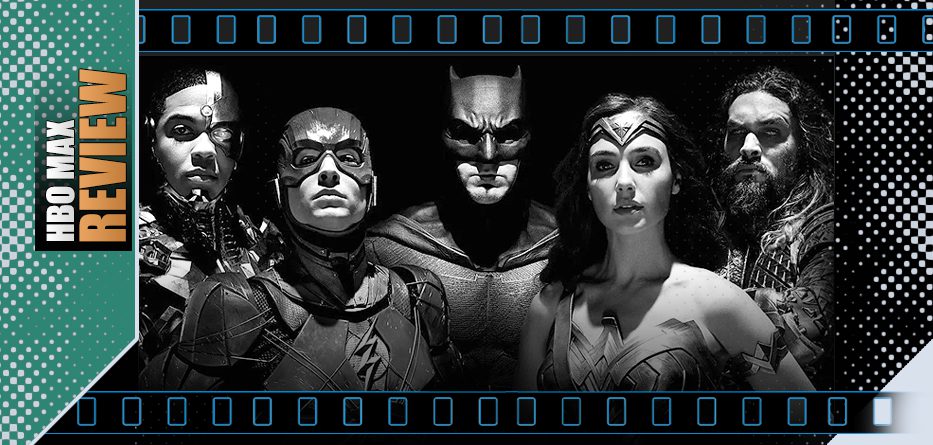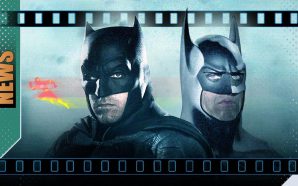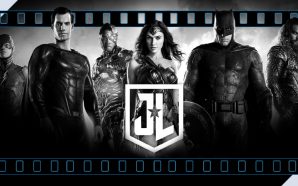Superman is gone and it’s left to Bruce Wayne and Diana Prince to seek out other super-powered beings to join them for a battle they sense is coming. But can they put together a team that can defend the Earth from a powerful cosmic force, one that has already ravaged entire worlds? Can cosmic ‘motherboxes’, separated across the planet – but now stirring to life once more – be stopped?
And even if such a team can be brought together what will be sacrificed along the way?
Is the future predestined and if not, who – or what – will shape it?
After a massive fan-campaign and millions invested in creating new effects and structure, fans are about to find out how a vision of the future can change…
*spoilers*
There’s an old maxim that said you were either a DC Comics devotee or a Marvel Fanboy… an imaginary, arbitrary division that suggested you gravitated towards one of the two major comic-book publishing companies and their different approach to the worlds of heroes and villains. It was never a firm line in the sand and though it has become far less distinct in the modern era, there is likely still some sort of hard-to-define preference, especially with the rise of the separate cinematic universes. I certainly grew up Marvel, but that in itself goes only some way into explaining that while I can remember almost every moment of Avengers: Endgame – and have watched it many times over – and yet I can barely recall but a handful of scenes from 2017’s Justice League (our review from the time is here) and really had no inclination of watching it again.
Except… of course…The Snyder Cut, the whole Whedon controversy, the fan-demanded, remolding of a core concept… all boiled down to the idle curiosity that says if you take a film and essentially double its length, is it the same movie or does it demand a wholesale re-evaluation. Will it be better, worse, or simply different?
The original Justice League movie picked up in a world without Superman – spoiler alert, the Man of Steel having died in his battle with Zod at the end of Dawn of Justice – first with a nostalgic video of Henry Cavill’s Superman being clumsily-interviewed by a group of High Schoolers before cutting forward to Ben Affleck’s Batman being more bleak than ever on a rooftop as ominous newspaper headlines of Metropolis’ loss flutter by. The Snyder Cut starts far differently, in the moment and speaking to cause and effect, Superman’s death-rattle sending out a literal shockwave around the world and being part of the reason that the film’s events actually begin. It’s a fundamentally different type of opening salvo and cinematic punctuation… and perhaps a statement of intent before the slowing down of pace.
‘Part One’ sees the establishing intros to Aquaman, Martha Wayne, Lois Lane and Wonder Woman reordered and extended, often coming with much looking into the far distance and various melancholy choirs paying homage in the background. It’s almost as if Snyder is telling the audience it’s all very grim, but to wait awhile… Next comes the appearance of Steppenwolf, receiving a substantial CGI upgrade as he runs amok through the Amazonian warriors. It’s certainly a more alien design, less enhanced prosthetics and more shiny, pixelated scales but as a character he’s still entirely one-dimensional.
With the later ‘parts’, we’re on to bigger things and the reveal that Steppenwolf, the big-bad of the previous version is merely a lackey, a herald for something worse. That would be Darkseid, whom we first see in an ancient battle royale (narrated by Diana) which feels very much like the Endgame battle, with a similar scope but none of the emotional impact… and unfortunately, in the wake of Marvel’s Thanos, this Big Bad, mostly kept away from the main action feels very much like a rather generic wannabe. Aquaman joins the battle far later in the running-time and then motormouth Barry Allen (The Flash), played by Ezra Miller, gets a much more fun introduction. While previously our first real sight of him was when Bruce Wayne caught up with him, now we see him save his future love-interest, Iris West, from an errant juggernaut while simultaneously interviewing for a pet store position. (The Bruce/Barry heart-to-heart comes about an hour later than the original’s and, in a poignant moment an extended shot shows a big banner for afsp.org (the American Foundation for Suicide Prevention) – presumably Snyder’s nod to the sad reason he had to leave the film in the first place, the death of his daughter, Autumn – to whom the film is dedicated).
There follows a series of deductions, encounters, epiphanies and battles, often rearranged from Whedon’s version and therefore often altering intentions, imperatives and interactions in meaningful ways. It’s clear that Snyder’s put real passion into the project (for personal and professional reasons) and while opinions of the result will vary, it’s hard not to applaud the obvious effort it took. Four hours is a considerable investment, even for the most die-hard fan and it’s unlikely that a majority of the audience will be able to spare the time to watch it in one sitting, at least not in this week of release. But it’s also true that the once-proposed ‘mini-series’ format of four hourly chapters would have had its own problems with pacing. That being said, it doesn’t actually feel like four hours and every character gets more depth and moments to shine. Notably, Victor Stone aka Cyborg (Ray Fisher) gets far more emotional arc throughout and the largely-exorcised story involving his father (played by Joe Morton) takes a far more pivotal arc in setting up the climax. Superman is resurrected as before, later but proportionally at about the same degree of over-all length with some of the same problems and more questioning of the decision, before and after.
But is the film actually better?
In this reviewer’s opinion, yes, notably so – but only grading on a curve. At least in some obvious ways it’s a massive improvement over the Warner Bros./Whedon’s halfway-house and what was, frankly an unexpected utter mess on first release. Certainly there feels to be more meat on this bone but also gristle, more reasoning but also ponderance and more sense of scale beyond de rigeur set-pieces, though sometimes it feels far too gleefully overwrought for its own good. But it would be wrong to equate ‘better’ with ‘great’. Avengers: Endgame earned every second of its satisfying running-time through years of prep, but Zack Snyder’s Justice League feels like the culmination of a story that hasn’t been fully told or earned. Even with Snyder’s far more dynamic vision and wholesale upgrade, it’s still ultimately a collection of random themes and ideas from the Warner/DC stable rather than an epic, intricate tableau built on firm foundations. The effects are good, sometimes very good and occasionally disappointing – though over-all far better than before. Yes, the legendary black/silver-costume of Superman replaces the red and blue and looks suitably more striking. Given that there’s a totally new climax -think of the last 30 minutes as playing out after the original ended – we also get to see more of our heroes in action and finally feel the weight of real stakes, though the film ultimately still feels more like a lengthy set-up for more.
Yet the most interesting thing here is simply taking the rare opportunity to see how a single film can change between two visions… and perhaps, in not micro-analyzing every change, tweak and reinvention but seeking to understand why those elements vary the result so much and so little depending on the moment. Money, time, hindsight? All of the above. In terms of architecture, it’s a taller, more foundational skyscraper with ‘more storeys, different flaws’. Some of the feature additions (including several new cameos) work to differing degrees of success. Whether you prefer this version or the original (and the fact is the truly superior film, if there is one, probably lies somewhere in between in both scope and running-time), this new Justice League stands uniquely as a monument to deferred intent… a still-fractured, if more complete vision to something now probably lost forever to time, opportunity and hubris… and with an intriguing and enigmatic cliffhanger’d epilogue – for a future adventure we’ll now never see – that’s single-handedly better than anything in the four hours preceding it and almost worth the wait.
But only almost.
Justice League: The Snyder Cut is streaming on HBO Max now…
- Story8
- Acting8
- Production Design / VFX8
- Direction8











